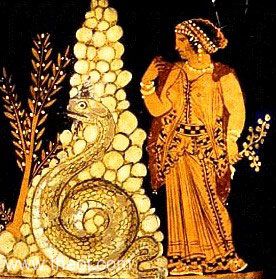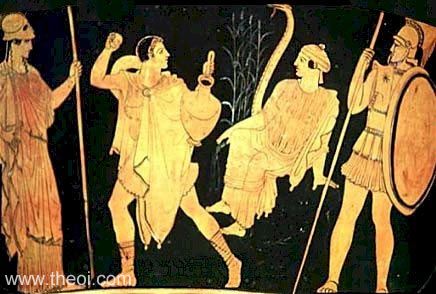MELIA
Greek Name
Μελια Μελιη
Transliteration
Melia, Meliê
Latin Spelling
Melia
Translation
Sweet, Honey (meli)

MELIA was the Okeanid-nymph of the Ismenian spring of Thebes in Boiotia (central Greece). She was loved by the god Apollon who slew her brother Kaanthos (Caanthus) in the contest for her love. She bore the god two sons, Ismenos and Teneros--prophetic priests of the oracular Ismenion shrine.
Melia as the Naiad-nymph of the Ismenian spring occurs in two alternate traditions as Melia and Ismene, ancestresses of Kadmos (Cadmus), the hero-founder of Thebes.
PARENTS
[1.1] OKEANOS (Pindar Paean 1, Pausanias 9.10.5)
OFFSPRING
[1.1] TENEROS (by Apollon) (Pindar Paean
1, Strabo 9.2.34)
[1.2] ISMENOS, TENEROS (by Apollon) (Pausanias 9.10.5, 9.26.1)
ENCYCLOPEDIA
ME′LIA (Melia), a nymph, a daughter of Oceanus. She was carried off by Apollo, and became by him the mother of Ismenius (some call her own brother Ismenus, Schol. ad Pind. Pyth. xi. 5; Tzetz. ad Lyc. 1211), and of the seer Tenerus. She was worshipped in the Apollonian sanctuary, the Ismenium, near Thebes. (Paus. ix. 10. § 5, 26, § 1; Strab. p. 413. )
Source: Dictionary of Greek and Roman Biography and Mythology.
ALTERNATE NAMES
Greek Name
Ισμενη
Transliteration
Ismenê
Latin Spelling
Ismene
Translation
Knowing (ismê)
CLASSICAL LITERATURE QUOTES

Pindar, Pythian Ode 11 str1 - ant1 (trans. Conway) (Greek lyric C5th B.C.)
:
"[In Thebes :] The shrine of Melia, to the treasure-house of golden tripods, the temple that above all
others Apollon held in honour, and he named it the Ismenion (Ismenium), the seat of prophecy that known no
lie."
Pindar, Paean 9 (trans. Sandys) (Greek lyric C5th B.C.) :
"By some might divine have I been prompted, hard by the immortal couch of Melia, to compose, for your sake,
a noble strain with my flute . . . Thine oracular shrine, Apollon; there it was that Melia, the daughter of
Okeanos (Oceanus), wedded to thy couch, O Pythian god, bare mighty Teneros (Tenerus), the chosen interpreter of
thy decrees."
Pindar, Fragment 29 :
"Shall we sing of Ismenos (Ismenus), or of Melia with her golden distaff . . . or Thebe with her purple
snood."
Corinna, Fragment 2 (trans. Campbell, Vol. Greek Lyric IV) (C5th B.C.) :
"[Verse of Pindar :] Gold-distaffed (khrysalakatos) Melia."
Strabo, Geography 9. 2. 34 (trans. Jones) (Greek geographer C1st B.C. to C1st A.D.)
:
"The Teneric Plain [in Boiotia] is named after Teneros (Tenerus). In myth he was the son of Apollon by
Melia, and was a prophet of the oracle on the Ptoüs Mountain, which the same poet calls three-peaked :
‘and once he took possession of the three-peaked hollow of Ptoüs.’ And he calls Teneros
‘temple minister, prophet, called by the same name as the plains.’"
Pausanias, Description of Greece 9. 10. 4-5 (trans. Jones) (Greek travelogue C2nd
A.D.) :
"By this fountain [the Ismenian spring of Thebes beside the sanctuary of Apollon Ismenios] is the grave of
Kaanthos (Caanthus). They say that he was brother to Melia and son to Okeanos (Oceanus), and that he was
commissioned by his father [Okeanos] to seek his sister, who had been carried away. Finding that Apollon had
Melia, and being unable to get her from him, he dared to set fire to the precinct of Apollon that is now called
the sanctuary of Ismenios. The god, according to the Thebans, shot him. Here then is the tomb of Kaanthos. They
say that Apollon had sons by Melia, to wit, Teneros (Tenerus) and Ismenos (Ismenus). To Teneros Apollon gave the
art of divination, and from Ismenos the river got its name. Not that the river was nameless before, if indeed it
was called Ladon before Ismenos was born to Apollon."
Pausanias, Description of Greece 9. 26. 1 :
"On the right of the sanctuary [of the Kabeiroi (Cabeiri) near Thebes in Boiotia] is a plain named after
Teneros the seer, whom they hold to be a son of Apollon by Melia."
SOURCES
GREEK
- Pindar, Odes - Greek Lyric C5th B.C.
- Pindar, Fragments - Greek Lyric C5th B.C.
- Strabo, Geography - Greek Geography C1st B.C. - C1st A.D.
- Pausanias, Description of Greece - Greek Travelogue C2nd A.D.
BIBLIOGRAPHY
A complete bibliography of the translations quoted on this page.